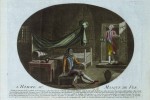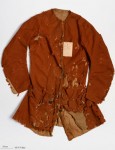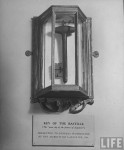 A new exhibit at the Arsenal Library branch of the French National Library called “La Bastille, or a Living Hell” is putting on display archives and artifacts of life inside the Bastille, fortress, prison and symbol of royal injustice whose destruction launched a revolution. The prison archives were thrown into ditches by the Parisians who stormed the Bastille on the 14th of July 1789. Nine years passed before the administrator of the Arsenal Library was able to get his hands on them, and there they remained generating surprisingly little interest for the next couple hundred years.
A new exhibit at the Arsenal Library branch of the French National Library called “La Bastille, or a Living Hell” is putting on display archives and artifacts of life inside the Bastille, fortress, prison and symbol of royal injustice whose destruction launched a revolution. The prison archives were thrown into ditches by the Parisians who stormed the Bastille on the 14th of July 1789. Nine years passed before the administrator of the Arsenal Library was able to get his hands on them, and there they remained generating surprisingly little interest for the next couple hundred years.
This exhibit is the first time the archives and artifacts have been gathered together for a comprehensive look at how prisoners in the Bastille really lived, as opposed to the fictional representations of revolutionary misinformation and propaganda. The high profile prisoners like Voltaire and the Marquis de Sade actually led a pretty cushy existence, complete with suites of rooms, their own furniture and dinner parties with outside guests.
 Even the poor prisoners — forgers, printers, Huguenots — lived in far more comfortable conditions than prisoners in any other prison in Paris. They each had their own cells and the prison could only hold a maximum of 50 prisoners, so there wasn’t anything like the squalor and horror that characterized most prisons.
Even the poor prisoners — forgers, printers, Huguenots — lived in far more comfortable conditions than prisoners in any other prison in Paris. They each had their own cells and the prison could only hold a maximum of 50 prisoners, so there wasn’t anything like the squalor and horror that characterized most prisons.
They were still in a 14th century fortress, though, locked behind 3 triple-locked doors, with highly restricted, censored communications and enforced secrecy. Prisoners were sent to the Bastille by secret order of the King. There was no trial, not even any explanation of the charges.
People were not put in the Bastille for crimes such as theft or murder. They were there for troubling the social order. This included Protestants, homosexuals, prostitutes, traitors, and anyone who dared say anything against the king or his reign — which meant most of the prisoners were authors, publishers and book peddlers.
Life inside the Bastille had its limitations, and communications with the outside world were strictly controlled. One prisoner sent a message on his handkerchief written out of coffee and soot, on display in the exhibit. Another smuggled his out in a cheese. One prisoner sewed a message onto a piece of cloth, claiming his innocence and asking whoever found it to help him.
“Secret is the word that defines this prison. Prisoners who left the Bastille would have to sign a register promising to never talk about the prisoners they saw in the Bastille or what they lived through,” Dutray said.
One story in the archives describes a terminally ill Protestant woman who was sent to the Bastille. Her daughter was allowed to accompany her even though the daughter was not technically under arrest. She remained by her mother’s side, hiding the truth of how ill her mother was from her captors to ensure she would not be forcibly converted to Catholicism, until her death. Once the woman died, officials didn’t want to release the daughter because she might talk, so they just kept her prisoner in the Bastille for a few years until finally sending her to a convent for the newly converted.
It was that secrecy which fed the rumors of torture and dark doings that would make the Bastille a symbol of royal abuse and a primary revolutionary target. When 8000 people stormed it on what would become known as Bastille Day, they found only 7 prisoners inside and a cache of gunpowder and weapons. They released the prisoners, dumped the archives, killed the governor and some of the guards, and the next day began to demolish the fortress itself.
 Today there are only a few stones of it left on Boulevard Henri IV, a miniature sculpture of the fortress carved out of one the building stones, a door and a few keys. Two of those keys are on display at the Arsenal Library exhibit.
Today there are only a few stones of it left on Boulevard Henri IV, a miniature sculpture of the fortress carved out of one the building stones, a door and a few keys. Two of those keys are on display at the Arsenal Library exhibit.
 One of them is part of the permanent collection of Mount Vernon. The Marquis de Lafayette presented the key to the west portal of the Bastille to George Washington along with a sketch of the fortress. In a letter dated March 17, 1790, he wrote “Give me leave, my dear General to present you with a picture of the Bastille, just as it looked a few days after I had ordered its demolition, with the main key of the fortress of despotism. It is a tribute, which I owe, as a son to my adoptive father, as an Aide-de-Camp to my General, as a Missionary of liberty to its Patriarch.”
One of them is part of the permanent collection of Mount Vernon. The Marquis de Lafayette presented the key to the west portal of the Bastille to George Washington along with a sketch of the fortress. In a letter dated March 17, 1790, he wrote “Give me leave, my dear General to present you with a picture of the Bastille, just as it looked a few days after I had ordered its demolition, with the main key of the fortress of despotism. It is a tribute, which I owe, as a son to my adoptive father, as an Aide-de-Camp to my General, as a Missionary of liberty to its Patriarch.”